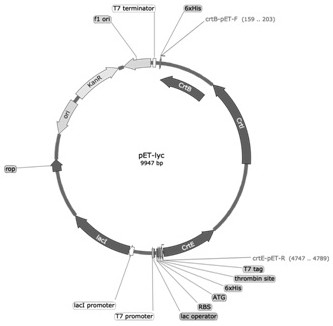Preparation method for synthesizing biosensor by using lycopene operon as well as corresponding biosensor and application thereof
A technology of lycopene and synthetic biology, which is applied in the fields of genetic engineering and molecular biology, to achieve the effects of high safety, convenient use, and improved synthesis efficiency
- Summary
- Abstract
- Description
- Claims
- Application Information
AI Technical Summary
Problems solved by technology
Method used
Image
Examples
Embodiment 1
[0039] Example 1: Gene acquisition and vector construction
[0040] 1. Gene acquisition
[0041]The lycopene operon (Addgene NO.53270) from Erwinia agglomerans, whose nucleotide sequence is shown in SEQ ID NO.1, was chemically synthesized on the pUC-57 vector by Golden Wisdom Company to obtain pUC-lyc vector.
[0042] The promoter yqjF (GenBank accession number is AAC76136.1) from Escherichia coli, whose nucleotide sequence is shown in SEQ ID NO.2, was chemically synthesized by Jinweizhi Company on the pUC-57 carrier to obtain pUC-yqjF vector.
[0043] 2. Construction of pET-lyc expression vector
[0044] Using pUC-lyc as a template, primer crtI-pET-F and primer crtE-pET-R, carry out polymerase chain reaction (PCR), amplify lyc fragment, and its PCR amplification system is as follows:
[0045]
[0046] The PCR program was: 95°C 3min; 30 cycles × (95°C 15s, 58°C 15s, 72°C 3min); 72°C 5min; 16°C ∞.
[0047] The primer sequences are as follows:
[0048] crtI-pET-F:
[0...
Embodiment 2
[0080] Example 2: Construction of XLYC1 recombinant strain
[0081] The pET-yqjF-lyc plasmid, pACYC-MvaE-MvaS-GPPS plasmid (cited from Yang J, Nie Q, Ren M, et al. Metabolic engineering of Escherichia coli for the biosynthesis of alpha-pinene. Biotechnology For Biofuels. 2013, 6 : 60.) and pTrc-low plasmid (cited from YangJ, Xian M, Su S, et a1. Enhancing production of bio-isoprene using hybrid MVApathway and isoprene synthase in E.coli.PLoS One.2012; 7:e33509.) Co-transform E.coli BL21(DE3) competent cells, spread on LB solid plates containing 34mg / L chloramphenicol, 100mg / L ampicillin and 30mg / L kanamycin to obtain positive clones, thus obtaining The engineered strain XLYC1 containing the vectors pET-yqjF-lyc, pACYC-MvaE-MvaS-GPPS plasmid and ptrc-low plasmid.
Embodiment 3
[0082] Example 3: Application of Visual Detection of Explosive Molecules
[0083] Conical flask detection: Pick the single colony of engineering Escherichia coli XLYC1 obtained in Example 2 into 10 mL of LB liquid medium containing 34 mg / L chloramphenicol, 100 mg / L ampicillin and 30 mg / L kanamycin, and place it at 37 ℃ Shaker overnight for activation; then transferred to 100mL M9 medium for expansion, and cultured to OD 600 For 0.6-0.8, add 0.5mM isopropyl-β-D-thiogalactoside (IPTG) for induction, add 50mg / L DNT to the positive control, incubate at 30°C on a shaker, and take pictures.
[0084] Anaerobic tube detection: Pick the single colony of engineering Escherichia coli XLYC1 obtained in Example 2 into 10 mL of LB liquid medium containing 34 mg / L chloramphenicol, 100 mg / L ampicillin and 30 mg / L kanamycin, and put it in 37 mg / L LB liquid medium. Incubate at ℃ in a shaker overnight for activation, then transfer to 2 mL of M9 medium, and cultivate to OD. 600 For 0.6-0.8, add...
PUM
 Login to View More
Login to View More Abstract
Description
Claims
Application Information
 Login to View More
Login to View More - R&D
- Intellectual Property
- Life Sciences
- Materials
- Tech Scout
- Unparalleled Data Quality
- Higher Quality Content
- 60% Fewer Hallucinations
Browse by: Latest US Patents, China's latest patents, Technical Efficacy Thesaurus, Application Domain, Technology Topic, Popular Technical Reports.
© 2025 PatSnap. All rights reserved.Legal|Privacy policy|Modern Slavery Act Transparency Statement|Sitemap|About US| Contact US: help@patsnap.com



